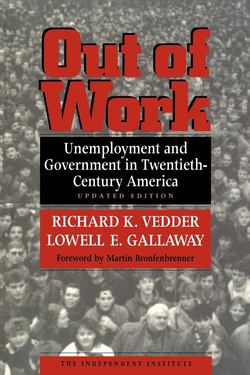Читать книгу Out of Work - Richard K Vedder - Страница 37
На сайте Литреса книга снята с продажи.
4
The Gilded Age
ОглавлениеIn many respects, the first three decades of the twentieth century were the golden age of the American economy. Despite the absence of national income statistics, it became very apparent during this period that America was the world’s premier economic power. The economic performance of the nation from 1900 to 1929 clearly established that this was “the American century” as far as economic growth was concerned.
Not only did real output expand at a very respectable 3.4 percent annual rate, but the growth far outdistanced that of older economies in Europe. It has been estimated that real output rose only 1.8 percent annually in the area constituting today’s European Economic Community (Common Market).1 There is some dispute as to how the fruits of this considerable economic progress were distributed.2 Yet there is no denying that the typical American family in 1929 owned a car, went to talking movies, listened to the radio, and owned a telephone—none of which was true in 1900. While his framework may be flawed, Walt Rostow makes a valid point in arguing the United States entered an “age of mass consumption” during this era.3
By the standard macroeconomic indicators of today, the first three decades of the century were highly successful. The inflation rate was 2.5 percent per annum, considered high by contemporaries but extremely low by present-day standards. Moreover, most of the inflation occurred in a few years during and immediately following World War I; during peacetime, prices were about as likely to fall in any given year as to rise.
Unemployment, as measured by the official Lebergott/BLS data, averaged only 4.67 percent for the thirty years 1900 through 1929, with the median unemployment rate being 4.30 percent. In only one year, 1921, did the unemployment rate average in double digits, and unemployment was under 3 percent more often (six versus four years) than it was above 7 percent.
Before extending our analysis of unemployment, it is very interesting to note that this era of prosperity and stability occurred during a period of relatively little government involvement in the economy. To be sure, there was an increase in some forms of regulation (passage and enforcement of antitrust laws, and railroad rate and food and drug regulation), the passage of a federal income tax amendment to the Constitution, and the beginning of institutional macroeconomic intervention with the creation of the Federal Reserve system. Collectively these factors led one distinguished economic historian to term the era 1897–1917 “the decline of laissez-faire.”4
Yet by modern-day standards, there was still a good bit of laissez-faire left in the American economy. Government purchases of goods and services absorbed only 8.2 percent of gross national product in 1929, and some 85 percent of that was carried on at the state and local level. After a high level of both spending and regulation during World War I, government involvement decreased during the 1920s, albeit to not quite as low levels as before the war.5 While it is true that total governmental expenditures rose from 7.7 percent of GNP in 1902 to 11.8 percent in 1929, the latter figure is only one-third the proportion of recent times; most of the growth in expenditures reflected high income elasticity of demand for goods and services traditionally provided by government, such as highways and education, rather than bold new forms of government involvement. The era was characterized by both relatively low levels of unemployment and relatively little state involvement in the economy.
